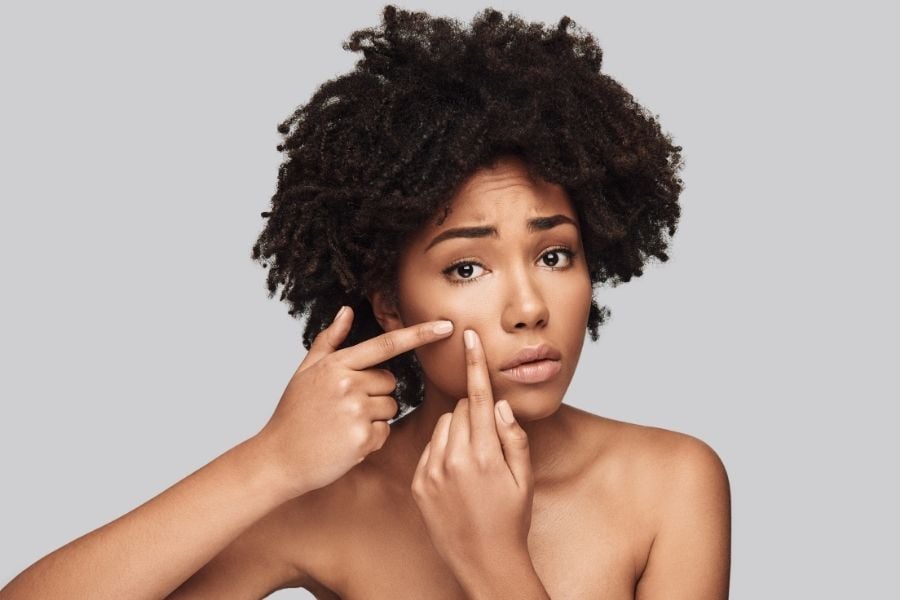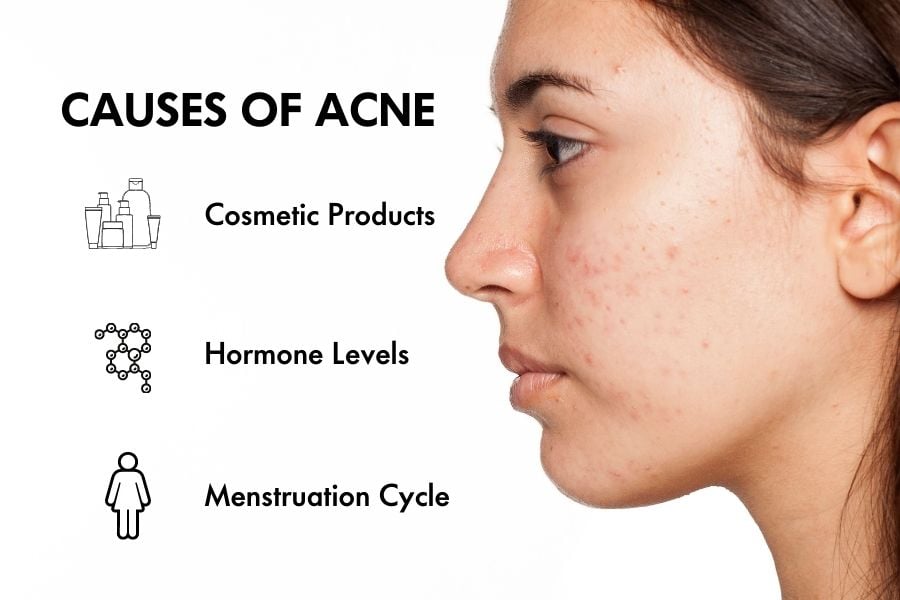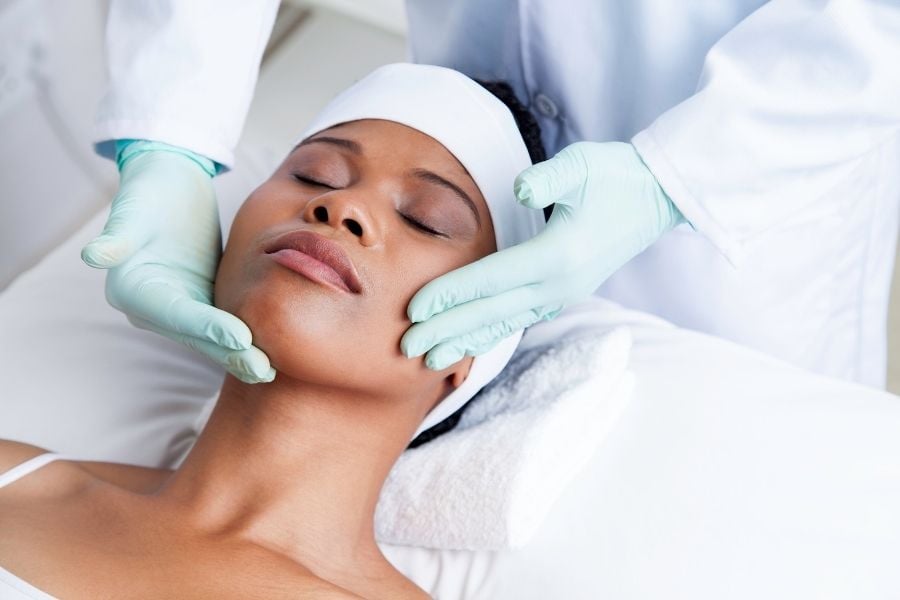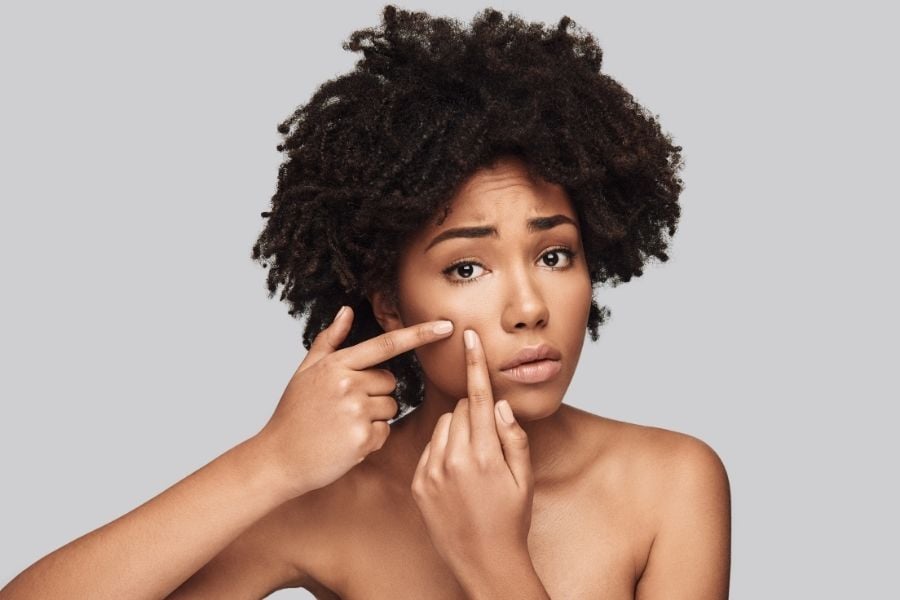One of the most common skin conditions that people face is acne. It affects most of us at some point in our lives, especially during our teen years.
Acne can come in mild, moderate and severe forms. For individuals who suffer from acne, it can have real emotional impacts. It’s frustrating, especially from a cosmetic perspective. It can lead to a crisis of self-confidence. You don’t like the way you look. Going to school, work, or just heading out into the public can be excruciating. It’s not fun. But there are pathways to clear skin. Everything comes down to determining the type of acne you have, the causes of it, and figuring out the best path that’s unique to your situation.

What Is Acne?
The exact causes of acne, both external and internal, are tough to pinpoint with any kind of exactitude, particularly dietary causes of acne, or something like inadequate face washing.
Basically, acne is caused when hormones, dead skin, skin oils and bacteria come together, resulting in inflammation and blockage of hair follicles. The skin contains many different hair follicles, or pores. Those follicles become infected.
Acne causes pimples and other skin abnormalities on the face, neck, shoulder, back and upper chest. There are different kinds of acne, varying in size and severity. There are blackheads, whiteheads, pimples, raised, solid bumps, surface bumps, or more serious kinds. Those are deeper and firmer or are larger, deeper pockets, like cysts and abscesses. The type and severity can be diagnosed by a doctor, as a first step.
What Causes Acne?
Pinpointing the exact cause of acne breakouts can be challenging. There are numerous factors, some more in our control than others, that can lead to the forming of acne.
There are certain cosmetics, lotions, soaps or cleaners that clog the skin’s pores and can cause acne. Also, many of us have noticed an increase in acne on hot and humid summer days, especially after wearing tight clothing.
During puberty, increased hormone levels stimulate the sebaceous glands, located in the middle layer of the skin, which secrets an oily substance called sebum. Sebum keeps your skin soft. When the skin follicles are blocked, and sebum can’t leave through the pores, that’s when you get acne. That’s why it’s particularly prevalent during teenage years.
Acne might also occur during the menstrual cycle for women. It could also worsen during pregnancy. With more people, acne lessens as they get into their 20s because hormone levels decrease.
Many people like to point to eating too much chocolate, or greasy food, as a cause. There is no scientific support for this. However it’s safe to say there are risks, in a diet rich in sugars and carbohydrates (on top of the overall health risks in diets that score high in those areas).
The bottom line is most of us get it or have had it. The question is determining the right path to deal with it and get rid of it.

How To Get Rid of Acne
Preventative measures include washing your face daily with a mild soap to remove oil and dirt from your skin. Using makeup that doesn’t clog the skin pores is also good. So is not picking at pimples, which can spread bacteria and oil.
If you have acne, there are various treatments. For example, with blackheads or whiteheads, there are a variety of cleaners, lotions, and spot treatments at the pharmacy. You might try benzoyl peroxide. That’s present in most acne creams or gels that you can pick up at your pharmacy. It dries out existing pimples and kills acne-causing bacteria. Talk to a dermatologist, if need be, for advice.
For moderate and severe acne, there are also stronger topical creams like prescription retinoic acid (helps create new skin cells which push dead skin cells and oil out of blocked pores) or medicine with higher concentrations of active ingredients, like azelaic acid, or topical antibiotics.
For acne that’s not responding to other treatments, the doctor will diagnose the medication isotretinoin by mouth. It works by decreasing facial oil (sebum) production. The doctor might also prescribe oral antibiotics.
Then there are treatments to remove damaged skin, and reduce skin oil production, like dermabrasion, where a plastic surgeon or dermatologist “sands” your skin with a special instrument. A chemical peel removes top layers of skin. Cortisone injections (cortisone is a steroid naturally produced by your body) is something your doctor might recommend, to help reduce inflammation and speed healing, in support of other treatments.
Photodynamic therapy is interesting since it’s becoming more popular. It’s a form of light therapy, for severe acne. A solution is applied topically that causes abnormal cells to produce light-absorbing molecules called porphyrins. And that allows the light treatment to better target the cells and bacteria causing the acne. This treatment also reduces the size and activity of oil-producing glands on the skin.

How To Remove Acne Scars
Acne breakouts are bad enough. But the scarring which severe types of acne can leave behind? Scarring occurs when acne breaks out so severely and deeply that it damages the tissues beneath it. That’s downright brutal.
However, there are advanced treatments to deal with scarring. The first step though is getting rid of the acne you have, since new outbreaks can lead to more scarring.
Seek out the advice of a dermatologist. HealthOne offers a Microneedling program (also called Collagen Induction Therapy) performed by their team of cosmetic nurses that triggers the skin’s natural repair processes (stimulates collagen and elastin production) and helps reduce the appearance of acne scars.
Other advanced treatment for acne scarring includes the Vivier hyperpigmentation program and NanoFractional RF treatment. This route improves the texture, tone and quality of the skin by using micro-focused, fractional radiofrequency energy that deeply heats the skin (rather than burning it, like with lasers), leading to faster rejuvenation and decreased healing times.
Bottom line: acne is common and it’s defeating. But you don’t have to just sit back and let it happen. There are things to do to avoid getting acne. And there is a long list of treatments you can turn to minimize it when you have an acne breakout and get rid of it entirely.
Broadening your knowledge about potential causes and treatments will put you on the better path to clear skin. Acne can form from a variety of factors, and there are many routes you can take while trying to treat it. You can take the path of trial and error, like trying a benzoyl peroxide spot treatment if you haven’t before. But when life with acne feels unbearable to face alone, the advice of a professional can offer deeper help and insights.

